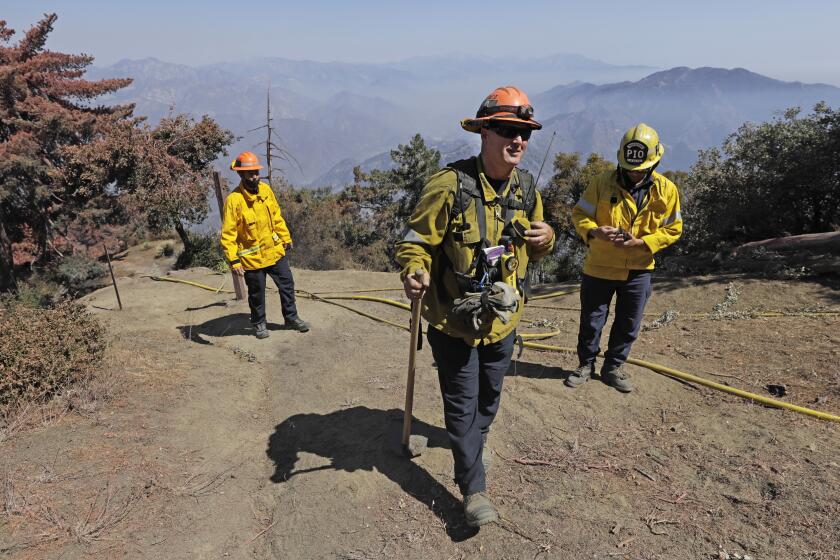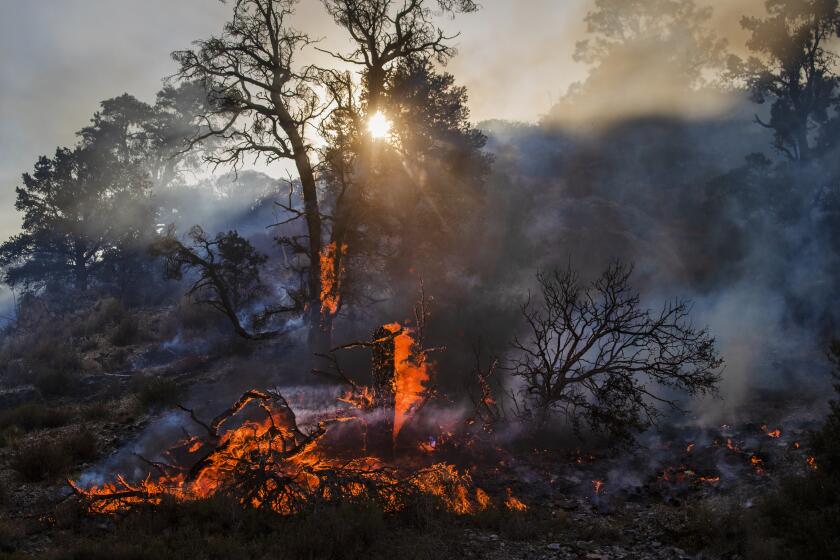Bobcat fire is personal to Jerry Garcia, a firefighter and ultra runner who knows land
- Share via
In the early days of the Bobcat fire, Crew 63 got a call to head for Angeles National Forest, into the mountains where flames barreled through tall grass and chaparral.
The fire was making a push toward Azusa Canyon, smoke blowing too thick for helicopter reconnaissance, so Jerry Garcia grabbed one of his men and hiked a few miles up a dirt road to scout the situation.
As a veteran crew boss for the U.S. Forest Service, Garcia was looking for a place where his people could make a stand. Though he had fought fires for more than a decade, this time felt different.
“Honestly,” he says, “my stomach was churning.”
There was room for his crew to start working with chainsaws and hand tools, so that wasn’t a problem. Something else bothered him.
Away from his job, Garcia ranks among Southern California’s top ultra runners, distinguishing himself among an uncommon band of athletes who test themselves on 100-mile courses, scrambling across wilderness through day and night.
Among the biggest worries of the Bobcat fire — now one of the largest in Los Angeles County history — has been Mt. Wilson.
How many early mornings had he spent in these mountains, running a myriad of trails, training to make himself stronger. The 42-year-old Altadena man saw an inferno obliterating thousands of acres where he had won a prestigious race only two years earlier.
“It was like watching your house burn down,” he says.
The churning in his stomach wasn’t fear. This fire was personal.
::
His dad was a runner but, other than some Little League baseball, Garcia wasn’t interested in sports as a kid. He was too busy running with gangs, getting in trouble with the law.
Trying for a better life, he joined the military and later attended Rio Hondo College in Whittier, where a counselor pointed him toward the wildland fire program.
There is nothing pretty about the job of fighting wildfires. Hand crews must hike perilously close to the flames, feeling the heat and breathing smoke, to create swaths of bare earth designed to stop the blaze from advancing. That means cutting brush away with chainsaws and clearing rough terrain with shovels and hoes.
“Definitely some good, hard manual labor,” Garcia says. “I was hooked from the beginning.”
The forest service brought him aboard as a seasonal employee after college. Around 2009, he was hired full-time and began working to become a crew boss. Each fire season got his adrenaline pumping.
“You never know where you’re going, where they are going to need you,” he says. “You could be watching a helicopter drop fire retardant in front of you and you’re getting ready to do an initial attack … for me, that’s the spark of why I’m out there.”
A few years into the job, a friend talked about running the half-marathon event at the 2009 Pasadena Marathon. Garcia was a gym rat — staying in shape for his job — and figured it wouldn’t be so tough jogging for a few hours.
Josh Allen might be the second coming of Ben Roethlisberger, but Rams cornerback Jalen Ramsey has ‘105 reasons’ the Bills shouldn’t throw his way.
Described by friends as an alpha-male type, very competitive, he signed up for the full 26.2 miles, arriving on race day in basketball shorts and cotton socks.
His body began cramping after six miles. Droves of runners passed by, people older than him, people who didn’t look nearly as fit.
“I got my butt kicked,” he says. “I was humiliated.”
::
First there was the running craze of the 1970s, which triggered a boom in marathons across the U.S. Looking for something more, hardcore runners began entering triathlons. Then came an even sterner challenge.
Ultra courses tend to stretch from 30 to 100 miles, often in harsh conditions. With 150 or so events nationwide, the niche sport represents about 1% of the overall running scene.
“It’s like a marriage of endurance and a love of outdoors,” says Tom Nielsen, a veteran ultra runner and coach. “Most of these events are in the mountains or wilderness.”
After that humiliation in Pasadena, Garcia responded in character, throwing himself into distance running, training in the pre-dawn hours before work. It made sense that he eventually gravitated from local marathons to endurance races in the mountains.
“I already had this love of nature from my job,” he says. “I got into trail running and went full-bore.”
It took a while to become competitive as Garcia focused on the Angeles Crest, a 100-mile race through the backcountry that takes about 20 hours or longer to complete. After a fourth-place finish in 2016, he sought help from Nielsen, who had won the race twice.
“Jerry had all the skills,” the coach recalls. “As far as training, I didn’t have to give him any nudging. He was an animal, doing runs longer than I suggested.”
If anything, Nielsen recommended a more-cautious approach for what he describes as a “race of attrition.”
At the 2017 Angeles Crest, Garcia paced himself in the early going, downshifting to a power-hike on steep climbs, mindful not to waste time while grabbing food and water at aid stations along the way. Falling 10 minutes behind the leaders, he reminded himself to stick to the plan.
His strength and agility allowed him to excel on the final downhill stretches, accelerating without tumbling or tripping on roots, even in the darkness. Over the last 10 miles, he burst into first place, flying past the house where he lives just off the El Prieto Trail.
“It’s like an art,” he says. “Every course is different and you have to find the right pace.”
::
Crew 63 was supposed to get a few days off after working 16-hour shifts for two straight weeks, but agreed to keep going another week.
Each morning, they pulled on yellow helmets and backpacks, trudging up the mountain to cut fire breaks. When the wind turned, blowing acrid smoke their way, crew members pulled bandanas over their faces. They always placed a lookout on a hill or ridge above, ready to holler if the blaze changed directions.
“The hottest part of the day, when the inversion layer lifts up, you start seeing the fire behavior get aggressive,” Garcia says. “There’s a lot of quick decision-making.”
The whole time, his stomach churned with a sense of urgency, an instinct to save the trails and woods that were like a second home. He says: “I have never felt so plugged-in, super pumped-up.”
Authorities on Friday afternoon lifted evacuation orders for parts of the Antelope Valley that had been threatened by the Bobcat fire.
Last Sunday, his crew was called to Mt. Wilson, arriving early to see flames threatening the observatory. It felt like a battle as they scrambled to prep a road and set a backfire. Later, they stood on the roof of the observatory’s café, spraying water as embers rained down.
The unrelenting blaze kept them at the observatory through late the next day. Working 40 straight hours, Garcia thought of his victory in the Angeles Crest race not so long ago.
“Having that experience of trail runs, I could tap into that and keep my body going,” he says. “I saw other people checking out mentally, but I had that extra push.”
Crew 63 eventually went home to recuperate for a few days. Until this weekend, when they headed back into the mountains.
More to Read
Go beyond the scoreboard
Get the latest on L.A.'s teams in the daily Sports Report newsletter.
You may occasionally receive promotional content from the Los Angeles Times.














